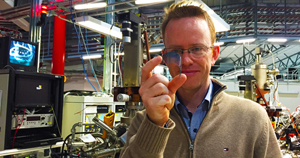- Details
A world where windows doubling as TV screens and solar panels could be found in every home is a step closer today after researchers from Monash University and the Australian Synchrotron helped produce the most effective and highest frequency printable organic transistor in the world, potentially paving the way for the rapid mass-production of cheaper and more versatile electronics.
The new approach to printing thin, durable semiconductor sheets using the groundbreaking polymer P(NDI2OD-T2), revealed in Nature Communications by Italian researchers from the Center for Nano Science and Technology in Milan and which could one day see the replacement of bulky, silicon-based circuit boards, could hasten the development of translucent consumer electronics.
Associate Professor Chris McNeill from the Department of Materials Science and Engineering at Monash University, whose team used the Australian Synchrotron to inform a new ‘bar-coating’ printing technique, says while many research teams have attempted to realise industry-ready printed polymer electronics, they had not been able to match high-throughput printing with high performance.
‘We discovered that molecules in the polymer must be precisely aligned, leading to this new bar-coating approach, an improved approach to “roll-out” printing, in which the polymer solution is spread into a thin film, much like a mound of dough is rolled flat by a rolling pin.
‘The trick to achieving high performance was tightly wrapping a wire around the “rolling pin” bar, creating a coat of microscopic grooves 50 microns wide – one twentieth of a millimetre – which forces the molecules of the polymer into an organised pattern during printing, for much greater electron mobility.’
Using the bar-coating technique the research team achieved a printing speed of six metres per minute, up to 50 times faster than other approaches to printing that also control the polymer’s molecular arrangement.
Associate Professor McNeill says the Melbourne team provided crucial molecular analysis as the technique was developed.
‘Working at the Synchrotron’s Soft X-ray Spectroscopy (SXR) and Small and Wide Angle X-ray Scattering (SAXS/WAXS) beamlines we defined the optimal molecular structure of the polymer, enabling our Italian research partners to print a polymer transistor that is not only much larger than any predecessor, but boasts a commercially competitive frequency of 3.3 megahertz.
‘We believe the upscaling of polymer transistors will enable faster development of next-generation electronics that are flexible, malleable and more affordable, beyond the limitations of bulky silicon-based transistors.’
The first working silicon transistor, the fundamental building block of modern electronic devices, was developed in 1954.
- Details
Researchers at St Vincent’s Institute of Medical Research (SVI) in Melbourne in collaboration with scientists at the Bio21 Institute, The University of Melbourne and the University of Oklahoma in the United States have shown how the bacteria Streptococcus pneumoniae (S. pneumoniae) assembles an arsenal of proteins to breech the membrane of human cells.
Infection by S. pneumoniae causes a range of serious human diseases including pneumonia, bronchitis, bacterial meningitis and sepsis. These bacteria are responsible for a quarter of the deaths of young children in the developing world.
It has been known for some time that the bacteria cause cellular damage via a toxin called pneumolysin. Pneumolysin is made up of individual components that assemble into a doughnut-shaped superstructure that punches a hole in the human cell wall, causing the cell to disintegrate.
Using the Macromolecular and Micromolecular Crystallography (MX1 and MX2) beamlines at the Australian Synchrotron, SVI researchers showed, for the first time, the initial few critical steps that occur in the formation of the superstructure.
Lead author Professor Michael Parker says pneumolysin first recognises human cells by binding to cholesterol in the cell membrane.
‘Once anchored on the cell surface it interacts with nearby pneumolysin molecules to form a linear array of toxin molecules.
‘Body temperature is sufficient to cause changes in the shape of the molecules to convert the linear array into doughnut-shaped rings that cause large holes to form in the cell membrane and allow the cell’s essential nutrients to escape.’
The emergence of drug resistant pneumococci and the poor efficacy of current vaccines have prompted the search for new vaccines and drug targets against the bacteria. This research provides a framework for the design of new vaccines and drugs to combat pneumococcal disease.
The work was published yesterday in the journal Scientific Reports.
- Details
Researchers at the ARC Centre of Excellence in Convergent Bio-Nano Science and Technology in Melbourne have worked with the Australian Synchrotron to develop a delivery system that releases a drug directly to the back of the eye to target macular degeneration, a progressive and often painful eye disease.
Led by Professor Ben Boyd, from the ARC Centre and the Monash Institute of Pharmaceutical Sciences, the research is part of broader work at the nanoscale to develop miniature delivery systems that release drugs when they are at the targeted organ.
Using technology developed with researchers on the Australian Synchrotron’s Small and Wide Angle X-ray Scattering (SAXS/WAXS) beamline, the research team devised a delivery system that is switched on by pulses of light, to unload its drug directly to the macula at the back of the eye.
The researchers use near-infrared light to open the nanopores (which are very small; a nanometer is a billionth of a metre) of the material containing the drug at exactly the right locations. Near-infrared light can penetrate tissue while keeping a straight path, so it can be precisely targeted.
Macular degeneration is the leading cause of blindness and major vision loss in Australia with one in seven Australians over 50 experiencing some level of the disease. Patients with macular degeneration require regular drug injections into the eye; Professor Boyd says the procedure is invasive, and the more injections you have, the greater the risk of infection, scarring and retinal damage.
‘A single injection that releases therapeutics is deployed when needed. Our research team is developing a delivery system that contains a drug that treats macular degeneration, such that when you shine light into the eye, a dose of the drug is released.
‘It’s a quick, safe and easy alternative to the current treatment regime of frequent, repeated injections into the eye.’
The research team are also developing versions of this treatment that do not require any injection in the eye, but target the eye after intravenous or subcutaneous injection, the latter acknowledged as more favourable for patients and could potentially be self-administered at home.
Professor Boyd said the research was enabled by the powerful light source and expertise of the Australian Synchrotron.
‘Working at the nanoscale, our experiments need to be precisely coordinated and our work would not have been possible without the accuracy and stability of the Australian Synchrotron’s very bright light.’


